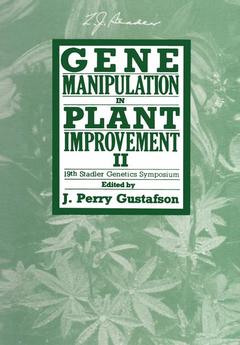Gene Manipulation in Plant Improvement II, Softcover reprint of the original 1st ed. 1990 19th Stadler Genetics Symposium Stadler Genetics Symposia Series
Langue : Anglais
Coordonnateur : Gustafson J. Perry

There are clearly many directions in which the further development of the GUS gene fusion system can progress. Some of these have been outlined above, but others can be imagined. There are no reasons to limit our conceptions of the use of GUS gene fusions to analysis and manipulation of single genes. We can envision numerous marked genes - perhaps with several new fusion systems - giving valuable information about gene interaction, or population structure. The study of plan- pathogen and plant symbiont interactions can progress rapidly with simple quantitative markers for genes and individuals. We can imagine ways of using gene fusions to report on crop physiology or other complex phenotypes, thereby enhancing the accuracy and speed of screening. Introduction of the biosynthetic pathway for glucuronide detoxification by expressing genes for the UDP-glucuronyl transferases in plants may result in novel mechanisms for plants to deal with xenobiotics such as insecticides or herbicides. Synthesis of substrates, which until now has been performed chemicall- resulting in expensive compounds - can be done biosynthetically. This should make the system not only the most powerful gene fusion system for agriculture, but also the most accessible.
Plant Breeding and the Value Contributed to Cereal Grain and Oilseed Production in Western Canada.- Self-pollinated Crop Breeding: Concepts and Success.- The Romance of Plant Breeding and Other Myths.- Targeting Genes for Genetic Manipulation in Crop Species.- Incompatibility Barriers Operating in Crosses of Oryza sativa With Related Species and Genera.- Wheat x Maize and Other Wide Sexual Hybrids: Their Potential For Genetic Manipulation and Crop Improvement.- Induced Mutations — An Integrating Tool in Genetics and Plant Breeding.- In Vitro Culture of Rice: Transformation and Regeneration of Protoplasts.- In Vitro Manipulation of Barley and Other Cereals.- Transformation and Regeneration of Non-Solanaceous Crop Plants.- Haploids in Cereal Improvement: Anther and Microspore Culture.- Transgenic Plants.- Transformation and Regeneration of Important Crop Plants: Rice as the Model System For Monocots.- Genetic Transformation of Maize Cells by Particle Bombardment and the Influence of Methylation on Foreign-Gene Expression.- Non-conventional Resistance to Viruses in Plants — Concepts and Risks.- Plant Transformation to Confer Resistance Against Virus Infection.- Using Plant Virus and Related RNA Sequences to Control Gene Expression.- Mapping in Maize Using RFLPs.- RFLP Mapping in Wheat — Progress and Problems.- New Approaches for Agricultural Molecular Biology: From Single Cells to Field Analysis.- Regulation of Plant Gene Expression by Auxins.- The Molecular Basis of Variation Affecting Gene Expression: Evidence From Studies on the Ribosomal RNA Gene Loci of Wheat.
Date de parution : 04-2012
Ouvrage de 438 p.
17.8x25.4 cm
Thèmes de Gene Manipulation in Plant Improvement II :
© 2024 LAVOISIER S.A.S.


